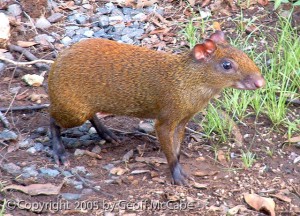- Home
- Accommodation
- Activities
- Area Info
- Maps
- Photo Galleries
- Real Estate
- Travel
Agouti
Spanish name: Aguti, Picure
Height/Weight: Head and body length ranges from 41.5 to 62 cm; they weigh about 4 kg.
Average Life Span: 14 years
Found In: Agoutis are commonly spotted in dense woody areas and forests in Central and Northern territory of Latin America. They are found in savannas, rainforests and cultivated fields.
 The agouti like several other native species can be spotted scampering hurriedly throughout Montezuma and its vicinity. They can be easily mistaken for rats and squirrels and are mostly spotted around fallen trees and marshy areas. The Agouti belongs to the tropical rodent family and looks something like a rabbit and squirrel. It is slightly bigger than a regular guinea pig. These creatures play a critical role in the eco system by dispersing seeds. Some seeds are dug out later, while the rest are just left there for the next batch of rainforest vegetation.
The agouti like several other native species can be spotted scampering hurriedly throughout Montezuma and its vicinity. They can be easily mistaken for rats and squirrels and are mostly spotted around fallen trees and marshy areas. The Agouti belongs to the tropical rodent family and looks something like a rabbit and squirrel. It is slightly bigger than a regular guinea pig. These creatures play a critical role in the eco system by dispersing seeds. Some seeds are dug out later, while the rest are just left there for the next batch of rainforest vegetation.
They are 16-25 inches long, including an inch long tail and can weigh anywhere near two to ten pounds. You can see them scampering around the parks, beaches and hotel lodges of Montezuma and will be forgiven for mistaking them for huge rats or squirrels with their hard and polished hair that is red or deep brown. Some of the agouti’s distinct features are its small eyes, jet black whiskers and a stub.
The agoutis are known to be smart hoarders. When excess food is available, they will bury the additional nuts and fruits in a variety of places throughout their marked space. Later, when food is scarce, the agouti will meticulously come back to the cache and consume the food that has been kept away for the rainy day. They don’t always recall where they’ve stores the food. These forgotten seeds then germinate and ultimately grow into healthy trees that help in maintaining the tropical eco system.
The agouti is mostly diurnal in nature unless it is too furiously chased and hunted when it becomes more active. It is a vital seed disperser for plants in the tropical rainforest habitat. The agouti will bury food in tiny batches that it goes back to get in the event of food scarcity. If it does not recover these seeds, they may grow into plants and replenish the sources from which the agouti feeds. An agouti can consume seeds with hard seed coats, since while eating it sits on the haunches to keep an eye out for predators. While resting on its hind legs, the agouti uses its front paws to hold on to the seeds. The agouti inhabit areas that possess a verdant undercover mostly bellow fallen trees, near water bodies or marshy areas. If the soil is moist enough in the areas they live in, they even start digging burrows.
These tiny mammals are monogamous and usually mate for life. The normal gestation period for an agouti is about three to four months. Their mating season goes on throughout the year especially when fruits are abundantly available.
A couple of agoutis are born at a time in the mother’s sleeping area. These creatures are known to be extremely active even at birth. The babies also select a site and prepare their own nest immediately after birth. Since the mother is too big to fit in their tiny nest she feeds the young ones in the morning and evening.
These smart and hard working mammals mainly convey information to each other via odor signals. For instance, they distinguish their territory, eating and sleeping areas by rubbing odor glands throughout the objects. Males will even separate prospective mates by spraying urine on them as part of their quirky ritual. Adult males fiercely defend their paths to establish the paternity of their offspring. They are blessed with a highly perceptive sense of smell and hearing, which helps them recognize the presence of predators and run at an alarmingly high speed.
Though agoutis are not decidedly antisocial, an individual agouti avoids aggressive behaviour with any other agouti that walks towards it, because such an action is seen to be confrontational. To fight, agoutis may kick each other with their sturdy hind legs or charge towards each other that can result in injuries for both. In case of a predator attack, however, their primary strategy is to scoot while letting out high pitched barks to warn others within the group. Their hair raises on the rump to appear much bigger in size than they actually are when they are directly confronted by a predator. This is to ensure that if a predator tries to bite their large lock of hair, they will miss the skin of the agouti, giving it a better opportunity to flee. When in danger, this clever mammal will straighten his long hair and run while venting out exceedingly high-pitched barks.
In Costa Rica, the agoutis are spotted mainly at the Santa Rosa National Park, La Selva, Corcovado National Park, Monteverde Cloud Forest Reserve and Children’s Eternal Rainforest. They may also be found in San Vito. In the forests of Nicaragua’s and Costa Rica’s Caribbean Coast, Agoutis are the most commonly spotted big rodents.
For More Information About the Agouti:
www.costaricajourneys.com/agouti/
www.conservenature.org/learn_about_wildlife/costa_rica…/agouti.htm
Agouti – Wikipedia
Great Stuff

Clandestina Restaurant
My new favorite restaurant, Clandestina is not to be missed by food lovers staying anywhere near to Montezuma. Established in March 2015, Clandestina is the new kid on the block. The Oregon/Tico collaboration is a winner among locals and travelers alike, with artisan craft beers, made onsite by Butterfly Brewing Co. and delicious, exciting […]











